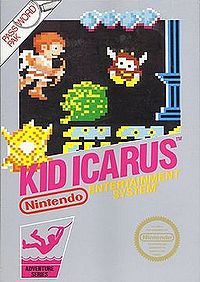| Kid Icarus | |
|---|---|
 File:KidIcarusSymbol.png | |
| Developer(s) | Nintendo R&D1 |
| Publisher(s) | Nintendo |
| Designer(s) | Satoru Okada |
| Released | |
| Genre(s) | Platformer |
| Platform(s) | Nintendo Entertainment System Family Computer Disk System Game Boy Advance Virtual Console |
| Article on Icaruspedia | Kid Icarus |
This article is about the video game. For the protagonist of the game who is sometimes referred to as "Kid Icarus", see Pit. For the universe, see Kid Icarus (universe).
Kid Icarus (光神話 パルテナの鏡, Hikari shinwa: Parutena no Kagami, Myth of Light: The Mirror of Palutena) is a platforming video game developed by Nintendo R&D1 and published by Nintendo for the Famicom Disk System in 1986 and the Nintendo Entertainment System in 1987. It is the first game in the Kid Icarus series, the second being Kid Icarus: Of Myths and Monsters, released on the Game Boy. Another sequel for the SNES, Kid Icarus 2, was never released. The game world is loosely based on Greek mythology, with Icarus and Medusa being drawn from myth.
Kid Icarus has been re-released twice: on August 10, 2004, for the Game Boy Advance as part of the Famicom Mini Series in Japan only, and on February 12, 2007, on the Wii's Virtual Console in North America. It was released on the European and Australian Virtual Consoles on February 23, 2007.
The game appears as a playable Masterpiece in Super Smash Bros. Brawl and Super Smash Bros. for Wii U. It can be played for 90 seconds in Brawl and 180 seconds in Smash Wii U, and starts at the first level.
In the Super Smash Bros. series
Characters
Pit (which appears as a playable character in both Super Smash Bros. Brawl and Super Smash Bros. 4) and Palutena (which appears as a playable character in Super Smash Bros. 4) both debuted in this game.
Moves
Pit's neutral, up and down specials in Brawl (Palutena's Arrow, Wings of Icarus and Mirror Shield) are based on the three sacred treasures from this game, the Arrow of Light, the Pegasus Wings and the Mirror Shield. Pit's Final Smash in Brawl, Palutena's Army, summons centurions to attack. Pit can free these soldiers using a Mallet, where they'll join with him to defeat the enemies. They're abundantly found petrified in Fortresses. Bopping one with a Mallet sends it flying away, and it'll join Pit during the fight against that Fortress' Sacred Guardian. Pit's Final Smash in Super Smash Bros. 4 is called "Three Sacred Treasures", and is based on the treasures mentioned above. More specifically, in their appearance in Kid Icarus: Uprising.
Stages
Skyworld is based on the location of the same name in this game. The same applies to Palutena's Temple.
Enemies
Daphnes, Monoeyes, Reapers and Zurees appear as Smash Run enemies in Super Smash Bros. for Nintendo 3DS. All of them debuted in this game.
Music
The songs "Underworld", "Skyworld", "Title (Kid Icarus)" and "Kid Icarus Original Medley" (known as "Kid Icarus Retro Medley in Smash 4) all come from this game. "Underworld" could be considered a medley of sorts, as while the majority of the track consists of an orchestral remix of the music that typically plays in World 1 of this game (officially known as Underworld), afterwards, a remix of the music that plays when Pit is in the range of the Grim Reaper enemy plays, and then the track ends on a remix of the Game Over Theme before looping again. "Skyworld" is an orchestral remix of the music that plays in the Overworld levels in this game, not the Skyworld as the song name suggests. "Title (Kid Icarus)" is a remix of the music that would play on the Title Screen of this game. "Kid Icarus Original/Retro Meldey" is a medley of music pieces from this game, retained in their original 8-bit format. The track starts with the Title Screen Theme, before transitioning into Underworld, the general Overworld Theme, Skyworld, Dungeon Theme, Stage Clear and Game Over. These segments are ported from the Famicom version of the game, rather than the NES version.
Other
In Super Smash Bros. Melee, Pit appears as a collectable trophy. The description includes "Will Pit ever fight again?", a possible hint that Pit could appear in a later game.
Gallery
| Masterpieces in Super Smash Bros. Brawl | |
|---|---|
| Starter games | Ice Climber · Kid Icarus · Kirby's Adventure · Star Fox 64 · Super Mario Bros. · Super Metroid · The Legend of Zelda |
| Japan-only games | EarthBound · Fire Emblem: Mystery of the Emblem |
| Unlockable games | Donkey Kong · F-Zero · Super Mario Bros. 2 · Super Mario World · The Legend of Zelda: Ocarina of Time |
| Masterpieces in Super Smash Bros. for Wii U | |
|---|---|
| Starter games | Balloon Fight · Donkey Kong · F-Zero · Kid Icarus · Kirby Super Star · Kirby's Dream Land · Mega Man 2 · Metroid · Pac-Man · Pilotwings · Super Mario Bros. · Super Mario Bros.: The Lost Levels · Super Mario Kart · Super Mario World · Super Metroid · The Legend of Zelda · Wrecking Crew · Zelda II: The Adventure of Link |
| Unlockable games | Dr. Mario · EarthBound · Kirby's Adventure · Punch-Out!! Featuring Mr. Dream · Yoshi |
| Japan-only games | Fire Emblem: Shadow Dragon and the Blade of Light |